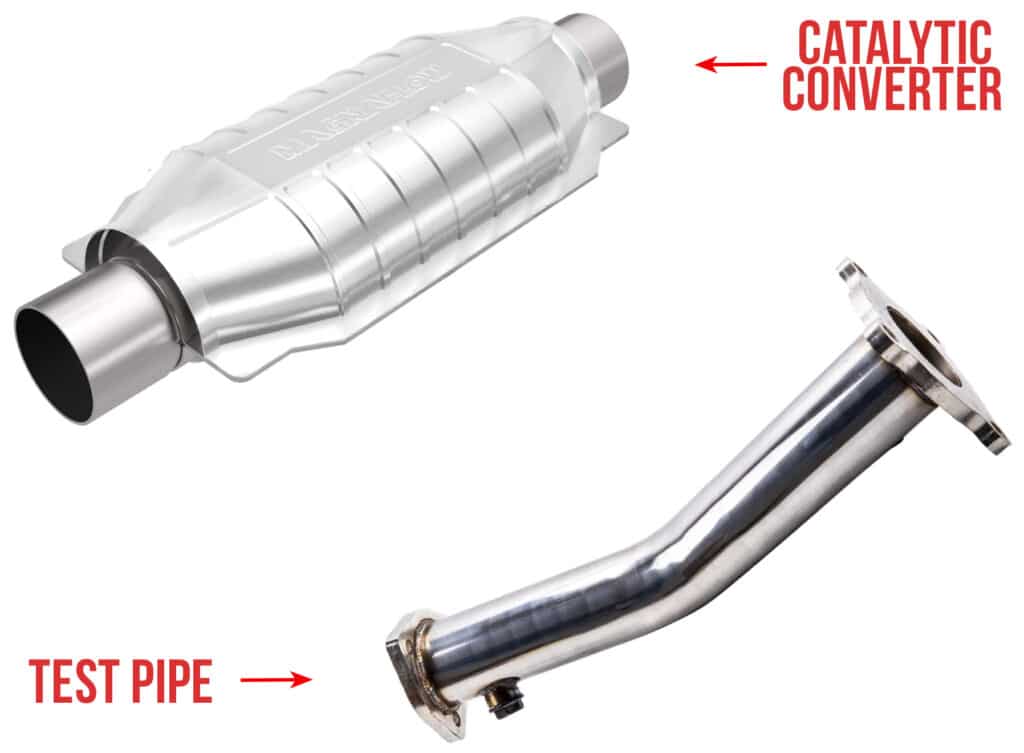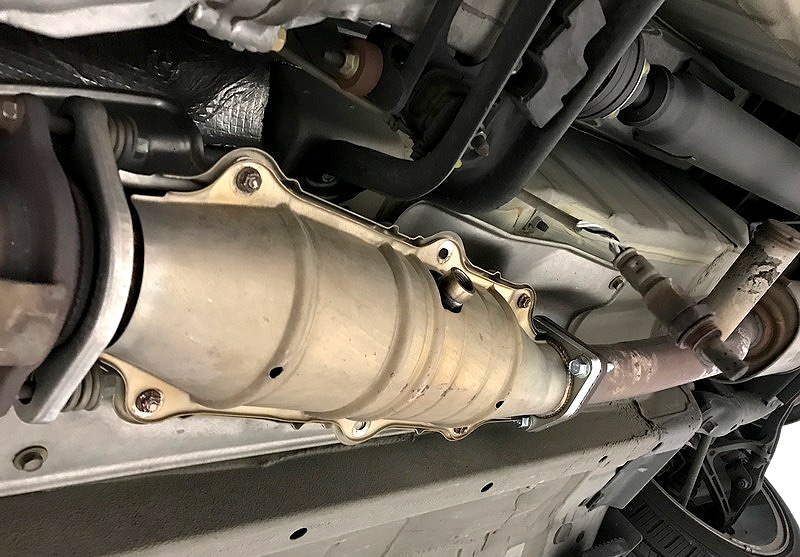Getting more power out of your engine starts and ends with airflow. That’s why the intake and exhaust components are typically the first to get upgraded.
Small gains from individual modifications to your intake and exhaust system might not seem like much, but they compound incredibly quickly.
This is especially true when you include supporting mods like plenum spacers, cold air intakes, catback exhausts, and headers in the mix.
Arguably, the most effective way to upgrade your exhaust system is to replace your catalytic converter with a test pipe.
You probably already know that the catalytic converter is the most restrictive component in your exhaust system.
Though we don’t recommend removing it, especially for daily driving, it’s something you can consider if you want to get the most out of your exhaust system.
In this article, we’ll discuss test pipes in detail by explaining what they do, how much horsepower you can realistically expect from this upgrade and some of the legal implications of removing your catalytic converter.
What Is a Test Pipe On a Car? What Does It Do?
The sole purpose of test pipes is to replace the cat-con. It is essentially an unrestricted, flanged straight pipe — very simple mechanically, nothing complicated going on here.
To understand why anyone would want to do this, we recommend reading our guide that explains what a catalytic converter is.

These are emissions control devices that help to rid the exhaust fumes of toxic gases such as carbon monoxide, nitrogen oxides, and hydrocarbons — all of which are poisonous to breathe for humans and animals.
In the process of cleaning up your exhaust fumes, catalytic converters end up creating a massive restriction in the exhaust system which increases back pressure and makes the exhaust scavenging effect less pronounced.
Needless to say, this saps a fair bit of power and keeps some of your engine’s potential locked away. When you run test pipes instead of catalytic converters, the exhaust fumes will escape your engine cylinders much quicker.
Of course, you need to get your ECU remapped for this to work properly.
Why They’re Called Test Pipes

As the name suggests, test pipes are intended for testing whether or not your catalytic converter is working the way it is supposed to. The idea is to use it to check if the cat-con is clogged, by comparing the difference in how the engine runs with and without it.
It is meant to be used as a temporary solution to verify just how much exhaust flow is being restricted, along with diagnosing a variety of other potential issues that the converter might be causing.
Some people decide to keep their test pipes on just for the sound and to avoid the costs of a new catalytic converter if the need arises. Others turn to aftermarket test pipes that are designed to maximize exhaust flow.
How Much Additional Power to Expect from Test Pipes?
Test pipes alone won’t really do much. Expect a gain of around 4 to 7 horsepower. This is barely enough to be noticeable, so don’t expect to be pushed back in your seat. However, you might find that the tacho needle climbs up the rev-range a bit quicker than usual.
To get the most out of this upgrade, we recommend getting your ECU remapped after installing an axle or catback exhaust system, aftermarket headers, and any short ram or cold air intake mods you can think of.
If you really don’t care about your neighbors, combine it with a muffler delete too.
If everything is done correctly, you can expect up to ~15 horsepower. Not bad especially for naturally aspirated builds.
Are Test Pipes Legal?
Now, this is the big question. Other than your car turning into a respiratory hazard, the other reason why you would want to avoid replacing your catalytic converter with a straight pipe is that it is illegal in many states.
By law, all cars are required to run cat-cons. While it’s easier to get away with test pipes in some states where they don’t check for emissions, others enforce strict regulations and hefty penalties.

It really depends on the jurisdiction in the region where you live. The guidelines surrounding the legality of catalytic converters were released by the EPA back in 1986. If you drive your car with a test pipe installed, you will most certainly fail either a state or federal emissions test.
And if you get caught driving without a cat-con, you will have to pay a fine of around £1,000 in the UK. In the US, you can very well be fined up to or more than $10,000, depending on where you live, and whether or not the officer is having a bad day.
For instance, California has the strictest laws pertaining to this; if you get caught driving around catless, you’ll definitely get a ticket and there’s a high chance of your car being impounded. But in Florida, it won’t matter as much.
With all that considered, it is up to you to take a call whether or not to use a straight pipe exhaust system your car. The way we see it, a couple of ponies here and there don’t really make a difference. And besides, test pipes will just make your car obnoxiously loud and the drone will drive you nuts on long drives.
If you really want to make your exhaust louder, there are other, more legal ways to go about it.
High Flow Cats and Resonated Test Pipes
Other than catback and axle back exhausts, installing high-flow catalytic converters or resonated test pipes are two viable options to make your exhaust sound better.
Just be mindful that one of these is still an illegal modification — resonated test pipes. High-flow cats, on the other hand, are legal for street use. Let’s discuss these in a little more detail.
High Flow Cats
If you really like the idea of installing a test pipe on your car but don’t want to deal with the moral and legal implications of removing your cat-con, there is a viable alternative for you — installing a high-flow catalytic converter.

These are essentially the same as regular catalytic converters but they’re designed to preserve power and still provide clean emissions.
Colloquially called high-flow cats, they contain larger cross-sections within the ceramic honeycomb structure — you know, the metallic mesh that’s coated with rare metals like Platinum (Pt), Palladium (Pd), and Rhodium (Rh). This is the part of the cat-con that cleans your exhaust fumes.
Having larger cross-sections within the honeycomb structure does a few interesting things:
- It allows for the inclusion of more catalysts.
- Maximizes the surface area within the ceramic chamber so that more contact can take place between the pollutants fumes and the rare metals.
The result is faster, more efficient purification of toxic fumes, without creating an enormous restriction in the exhaust flow path.
You’ll come across two types of high-flow cats: those with a ceramic core and those with a metallic core. We recommend the ceramic core variants because they last longer and are sufficiently durable.
Resonated Test Pipes

Resonated test pipes are just like regular test pipes, except they have something called a Helmholtz resonator attached to them.
This makes them flow better than the stock cat-con and high-flow cats, and they’ll drone a lot less than non-resonated test pipes.
Though they’re a bit more expensive than non-resonated test pipes, the performance remains unaffected. Expect moderate horsepower and torque gains.
Conclusion: Should You Straight Pipe Your Car?
Honestly, if you want serious power gains, superchargers and turbochargers are your best bet. Intake and exhaust upgrades can only do so much.
Unless you know exactly what you’re doing and have big plans for your entire exhaust system, we’d advise you to steer clear from test pipes.
Unless you’re taking your car to the track frequently, or if you have a dedicated track car, there isn’t much to be gained from test pipes.
If exhaust sound is what you’re after, your best option is to install a good quality catback exhaust system.
What’s your take on test pipes? Would you run them on your car? Let us know by leaving a comment below!


1 comment
I have a vehicle that has been throwing an erroneous fault code since 80,000 miles. The corporate diagnostic leads to a final step of “replace catalytic converters”.even though there is no signs of excessive exhaust emissions, in fact the dealer said, after reflating the ecu twice, he would refuse to replace the converters because it probably would not make the problem go away. It is simply a matter of getting O2 sensors and other sensors at opposite ends of tolerance limits and when combined the arithmetic reliability is below that which produces accurate readings. When I use a lab grade O2 sensor, exhaust sensor, and gas analyzers, all is ok. So I have to drive the last 80,000 miles with a check engine light on. I now have 165k on the odo. I have paid my debt to society. The engine is a clean running, new technology model. The converter is tree hugger nonscientific burden. That is my legitimate reason. How do you like them apples?